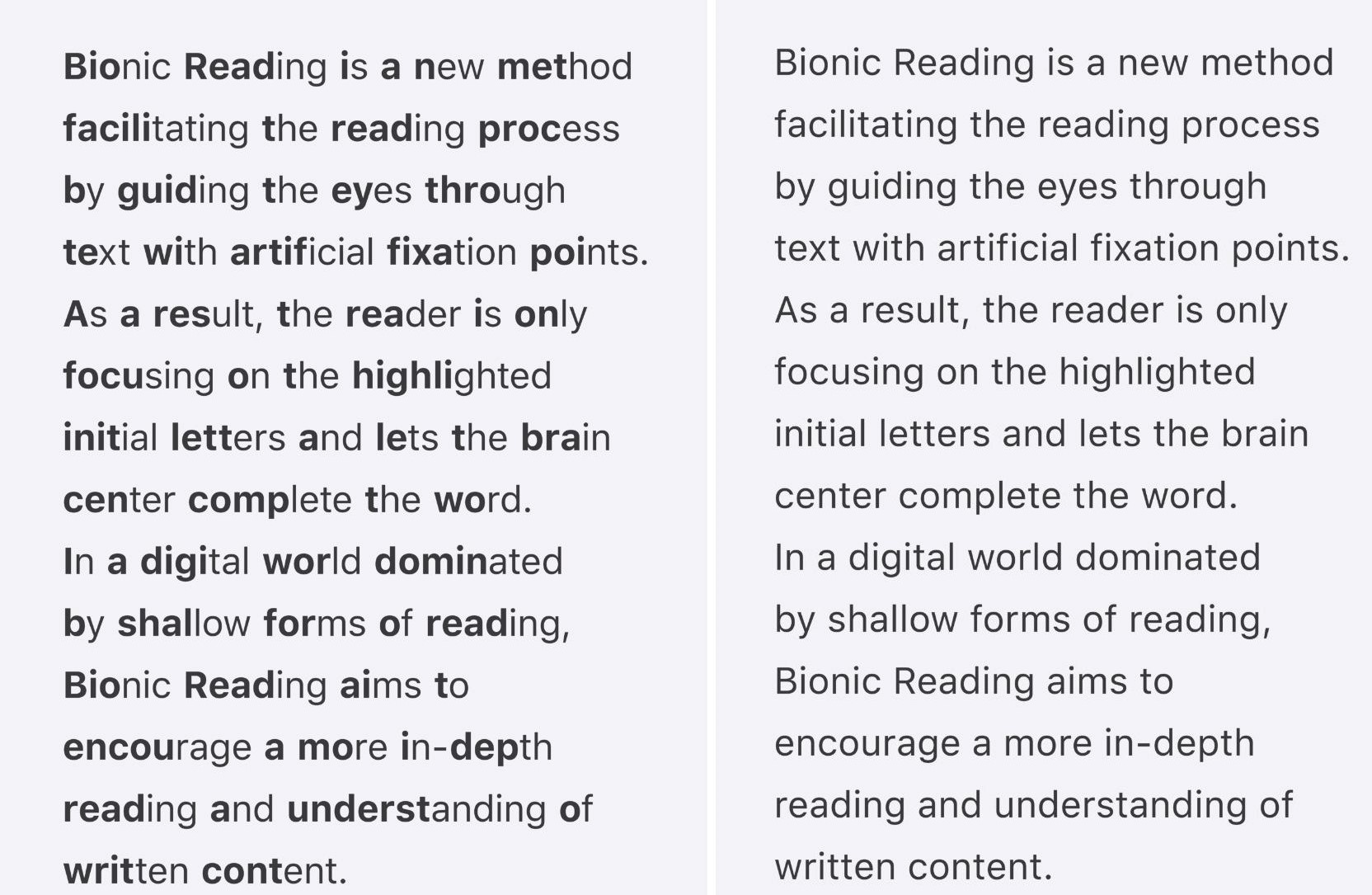Reading is a great pastime when you want to just unwind and relax, but for some, reading through blocks of texts is a challenge. Most likely within the neurodivergent spectrum, there are readers out there who struggle to thoroughly enjoy a book. Blocks of texts become overwhelming to understand over time, which eventually force these readers to skim over words and not focus well on the content. However, a new typeface has recently been developed, and it could be a real game-changer for neurodivergent readers.
Bionic reading is a new Application Programming Interface (API) that aims to improve one’s reading skills. It is a new typeface wherein the first few letters of the words are in bold, which then acts as “fixation points” to help guide the eyes more easily through the text. With the fixation points, readers only need to focus on the letters that are in bold while the brain center completes the words. The initial few letters of the text are in bold to help readers focus on the content.
The concept of bionic reading was shared on Twitter, and while some people seemed pleased with it, some expressed their disappointment because it didn’t work for them when they tried it out.
A new type of typeface might be beneficial to neurodivergent readers! 🤯
It's called bionic reading — the first few letters are bolded, making it easier for readers to glide through text and stay focused.
(links in reply) pic.twitter.com/ssescp8smN
— Sydni (What in the ADHD?) (@WhatTheADHD) May 20, 2022
I like how I read the first one w ease & then I looked at the second one & decided “I aint readin that” despite them having the same content.
— R A V E N 👩🏾💻🩷🌙 (@ItsRaeDickerson) May 20, 2022
https://twitter.com/borland/status/1527798192183853056?s=20&t=4WcaHFrz3p2QxFXxipbyrA
!!! I read the whole paragraph on the left without my eyebrain going into skim mode!!!
THIS WOULD SAVE ME SO MUCH TIME!
Imagine being able to get back all those wasted seconds having to re-read a paragraph again and again and AGAIN to actually understand it! It was so quick!— 12 Vultures In A Trenchcoat (@AshKeith4) May 20, 2022
Ugh, that's horrible for speed readers. Normally, I can scan the whole page at the glance & know every word, but this makes my head hurt. Have to read it like a third grader.
— Lovings Webmistress, backup (@lovingsgirl) May 21, 2022
Oof. This had the opposite effect for me, sort of. Made the reading jagged and full of abrupt stops, like someone just learning to drive and hitting the brake over and over. Ended up being even MORE distracting than just letting the words glide over me.
— Author Kat Quinn (she/her) (@AuthorKatQuinn) May 20, 2022
https://twitter.com/simon_hawthorn/status/1527648035215495168?s=20&t=4WcaHFrz3p2QxFXxipbyrA
Renato Casutt, one of the developers of Bionic Reading, had taken notice of the mixed reactions to the new typeface. In response, he created a Twitter thread on May 24, 2022, detailing the background of the project. Casutt shared that the idea of Bionic Reading already existed as early as 2009, back when he was still studying to be a typographic designer. He started working on the typeface in 2016, alongside two people who collaborated with him by contributing their knowledge of software development.
For the next 6 years up to now, he continued testing out the typeface and developed a matrix he designed so that Bionic Reading may be set as an optional reading method so that readers may choose to enable the typeface. Earlier this year, Casutt managed to do a preliminary study with a university in Switzerland to test whether or not Bionic Reading was an effective reading method. He shared that the results of the experiment were “not clear,” but the majority of the tests had a positive result, noting that there were also some who found the typeface effect “disturbing.” He mentioned in the thread that it hasn’t been explicitly tested whether or not the reading method is effective for dyslexics. However, he did add that there were some who personally told him that Bionic Reading does help dyslexic people.
If you want to learn more about Bionic Reading or want to test it out yourself, their website offers a downloadable Chrome Extension for Bionic Reading, as well as a Bionic Reading Converter and Bionic Reading API. /TV
Other POP! stories you might like:
You can spot popular brand logos in this new quirky downloadable typeface
Deaf artist makes Filipino sign language guide for Dungeons & Dragons
DeafEd: #EndingLanguageBarrier through Filipino Sign Language & Braille



